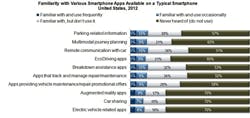Global research and consulting firm Frost & Sullivan’s upcoming report, entitled Aftermarket Automotive Apps: Strategic Analysis of Vehicle Information, Service and Management Apps finds that various participants in the automotive value chain, particularly OEMs and third-party developers, are increasingly introducing different apps that provide vehicle owners a range of utilitarian and critical functionalities to help them better manage their cars.
Like this article? Sign up for our enews blasts here.
The list of vehicle management features available through either smartphone or in-vehicle apps is still limited to functions such as basic diagnostic alerts, service and dealership locations, parts and vehicle pricing information, promotions, roadside assistance and service scheduling. However, moving forward, OEMs are well positioned to add features such as remote diagnostics and prognostics through an app-driven platform, as well as functionalities that provide more integrated communication with their respective original equipment service (OES) channels.
The above trend poses a rising threat to aftermarket participants, particularly retailers and distributors. OEMs are looking to enhance customer loyalty and convenience by making it easier for vehicle owners to track their maintenance and proactively guiding them to the OES channel through greater communication with dealers. In turn, this may lead to greater parts and service revenue for vehicle manufacturers. Every customer gained by the OES channel is potentially a customer lost by the independent channel — precisely why aftermarket retailers and distributors should increasingly focus on developing a killer mobile app strategy.
The combination of these market drivers is creating the ideal environment for the adoption of apps. The automotive industry has been somewhat late in arriving into the app world. Ford was one of the first automakers to sniff out the opportunity, but OEMs such as General Motors and BMW are showing growing interest in taking the lead in vehicle management apps. Even dealers have jumped on the bandwagon with a flurry of branded app releases in 2011.
In this scenario, aftermarket participants, with some notable exceptions such as AutoZone, Midas and Jiffy Lube, are still showing some reluctance in taking the bull by the horns. While many key players still do not have apps out in the market, those who do are primarily using it as a basic customer convenience tool. Going forward, some participants are likely to make apps a more integral part of their overall e-commerce strategy, but based on current trends, these will be few and far between in the near-term. Lack of a proper strategy or business model surrounding apps may not have a major impact on channel growth in the current climate, but the future may not prove to be as kind to the bottomline. Indeed, the writing on the wall is probably available at an app store near you.
.gif?auto=format,compress&fit=max&q=45&w=250&width=250)
.gif?auto=format,compress&fit=max&q=45&w=250&width=250)


